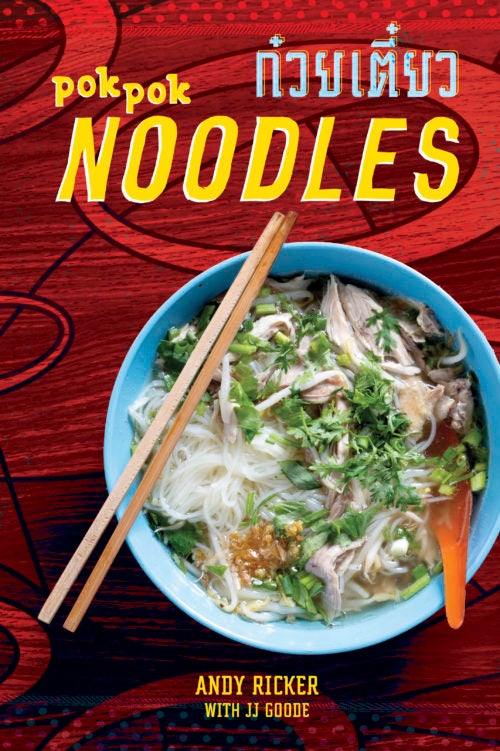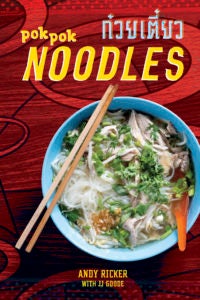




























I was meeting my friend Ajaan Sunee for lunch at Chiang Mai University when I first encountered this unassuming stir-fry. Ajaan Sunee, the college’s home ec professor at the time, took me to the school’s cafeteria, which students swarmed between classes. In particular, they crowded around a vendor renowned for her MAMA phat. The dish is typical college-kid fare—economical, simple, filling. It was a testament to this cook’s talent that she could inspire such enthusiasm for what is essentially a collection of the least expensive ingredients available—cabbage, carrot, onion, and briefly boiled instant noodles—tossed for a spell in a hot wok. Made with care, though, the dish transcends its status to become something I’d gladly eat any time.
Compared to most versions, this recipe calls for a goddamn panoply of vegetables, all of which count as suggestions that you can take or leave. One of the great things about MAMA phat is that it’s a delicious fridge-clearer. Virtually any vegetable is welcome. The pork, too, can be swapped at will for shrimp, chicken, or tofu. Just don’t get fancy with the noodles.
Directions
- Put the bones in a large pot and add enough cold water to cover them by 1 inch or so. Cover the pot and bring the water to a simmer over high heat, then turn off the heat. Skim any scum from the surface, then drain the bones and rinse them well under cold running water. All this is to get any blood off the bones, which will give you a cleaner-tasting, clearer stock.
- Clean the pot, return the bones to the pot, and add enough of the 5 quarts water to cover by an inch or so. Bring the water to a bare simmer over high heat, lower the heat to maintain a bare simmer, and cook, skimming off any surface scum occasionally, until all of the flavor has been cooked out of the meat on the bones, about 2 ½ hours.
- Working with one ingredient at a time, use a pestle or heavy pan to lightly whack the garlic, ginger, cilantro roots, and lemongrass to bruise them. Very roughly slice the ginger and lemongrass. After the bones have simmered for 2 ½ hours, add the bruised aromatics to the pot along with the daikon, green onions, Chinese celery, and peppercorns. Simmer gently for 30 minutes more. Strain the stock into a large bowl or pot (don’t press the solids) and discard the solids. Use the stock now, or let it cool and then store in airtight containers in the fridge for up to 5 days or in the freezer for up to 6 months.
- In a small bowl, combine the pork, garlic, seasoning sauce, fish sauce, and pepper. Mix well with your hands, then let marinate for 5 minutes or so.
- In a small bowl, combine the cabbage, bean sprouts, carrot, onion, and yu choy and set aside.
- Fill a large, tall pot with enough water to submerge a long-handled noodle basket and bring to a boil over high heat. Put instant ramen noodles in the basket (breaking the noodles slightly to fit if need be) and submerge the noodles in the boiling water. Cook, stirring occasionally with chopsticks to separate, until the noodles are tender, about 2 minutes. Firmly shake the basket to drain well and set aside.
- Set a flat-bottomed wok over very high heat and heat until it begins to smoke lightly. Add the oil and swirl the wok to coat the sides. Add the pork mixture and stir-fry, constantly stirring, scooping, and flipping the ingredients, until the outsides of the pork are no longer raw, 5 to 10 seconds. Push to one side of the wok, then crack the egg onto the other side and cook until the white is nearly set, about 15 seconds. Flip the egg (it’s okay if the yolk breaks) and stir-fry, breaking up the egg slightly, until it’s just about fully cooked, about 10 seconds more.
- Add the noodles and cabbage mixture and stir-fry until the vegetables are wilted and just tender, about 45 seconds. Add the pork stock, seasoning sauce, and oyster sauce and stir well. Add the sugar and pepper, stir-fry for 10 seconds, and turn off the heat.
- Transfer to a plate and sprinkle with the green onion.
Reprinted with permission from POK POK Noodles, copyright © 2019 by Andy Ricker and JJ Goode. Published by Ten Speed Press, an imprint of Penguin Random House LLC. Photographs copyright © 2019 by Austin Bush

